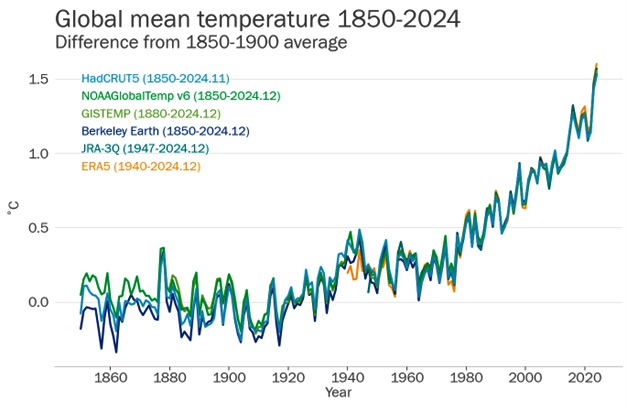2024 global temperatures surpassed 1.5°C Paris Agreement threshold, confirms WMO

The confirmation was announced by the World Meteorological Organization (WMO) – the United Nations’ climate organisation – detailing the number was 1.55°C (with a margin of uncertainty of ± 0.13°C) above the years 1850-1900 average.
This number is significant as 1.5°C is one of the key internationally agreed warming thresholds set out in the 2015 Paris Agreement, to combat climate change.
Hottest year on record – again
The report also confirmed that 2024 was – unsurprisingly – the warmest year on record.
“Climate history is playing out before our eyes,” said WMO Secretary-General Celeste Saulo.
“We’ve had not just one or two record-breaking years but a full 10-year series. This has been accompanied by devastating and extreme weather, rising sea levels and melting ice, all powered by record-breaking greenhouse gas levels due to human activities.”
In Australia, the ‘hottest year’ record has been broken four times in the last decade – in 2015, 2016, 2023, and now in 2024.
Crunching the numbers
The WMO used six international datasets to confirm the figure. These were gathered from the European Centre for Medium-Range Weather Forecasts (ECMWF), the Japan Meteorological Agency, NASA, the US National Oceanic and Atmospheric Administration (NOAA), the UK’s Met Office in collaboration with the Climatic Research Unit at the University of East Anglia (HadCRUT), and Berkeley Earth.

According to a WMO statement, four of the six datasets indicated a higher than 1.5℃ global average increase for the whole of last year. Due to differing methodologies across the six datasets, two of the six did not.
“The assessment proves yet again [that] global heating is a cold, hard fact,” said UN Secretary-General António Guterres.
A separate study published in Advances in Atmospheric Sciences found that ocean warming in 2024 played a key role in the overall high global temperatures.
What about Paris?
The 2015 Paris Agreement, adopted by 196 Parties, set a goal to ensure global temperatures do not rise more than 1.5℃ above pre-industrial levels, while striving to hold the overall increase to well below 2℃.
However, a single year of temperatures breaching 1.5°C does not mean the Paris Agreement has failed.
“Individual years pushing past the 1.5°C limit do not mean the long-term goal is shot,” Guterres said.
“Long-term temperature goals…are measured over decades rather than an individual year.”
He added, “There’s still time to avoid the worst of climate catastrophe. But leaders must act – now.
“Blazing temperatures in 2024 require trailblazing climate action in 2025.”
Reactions from Australia’s scientific community
“While climate trends can’t be fully understood by focusing on just one year, the news that 2024 has surpassed 1.5°C above pre-industrial levels for the first time is deeply concerning,” said Dr Kerryn Hawke, a lecturer in the School of Environmental and Conservation Sciences at Murdoch University.
“This, coupled with the rise in global temperatures and increasing impacts that we have been seeing over the first part of the 21st century, highlights the urgency of the situation.
“While ‘global temperatures’ and ‘1.5°C above pre-industrial levels’ may seem quite remote and arbitrary, we hear on the news or ourselves experience the effects of human-driven climate change every day – events such as hotter days, heatwaves, wildfires, heavy rain and flooding.
“As scientists, we also see the clear fingerprints of human-driven climate change on large-scale atmospheric processes.”

Colin David Butler, an Honorary Professor at Australian National University’s National Centre for Epidemiology and Population Health and the Institute for Climate, Energy and Disaster Solutions, disagreed with the notion that the Paris Agreement has not failed.
“This is only true technically,” Butler said. “Many climate experts cling to hope that the global temperatures will only temporarily overshoot the 1.5°C goal. Unfortunately, this too is wishful thinking.
“We are in the early stages of an emergency that endangers planetary civilisation.”
Dr Michael Grose, a climate scientist at CSIRO, said, “We can now say that the Australian long-term temperature trend (not just a single year) is above 1.5 degrees, joining many other national average trends – reflecting the higher rate of warming over land than ocean.”
He added, “If we reach net zero, then we expect global average temperature to stabilise fairly quickly as the net result of various processes. But we know that the regional climate would still change for a long time to come, especially aspects to do with the slow processes in the oceans and ice – such as sea level rise.”





